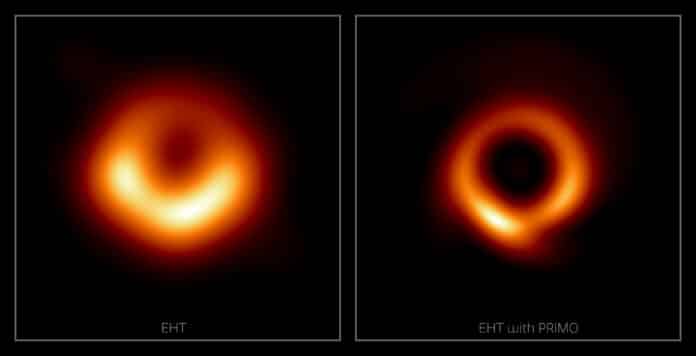A team of researchers, including an astronomer with NSF’s NOIRLab, has developed a new machine-learning technique to enhance the fidelity and sharpness of radio interferometry images. To demonstrate the power of their new approach, which is called PRIMO, the team created a new, high-fidelity version of the iconic Event Horizon Telescope’s image of the supermassive black hole at the center of Messier 87, a giant elliptical galaxy located 55 million light-years from Earth.
The iconic image of the supermassive black hole at the center of Messier 87 has received its first official makeover, thanks to a new machine-learning technique known as PRIMO. This new image better illustrates the full extent of the object’s dark central region and the surprisingly narrow outer ring. To achieve this result, a team of researchers used the original 2017 data obtained by the Event Horizon Telescope (EHT) collaboration and created a new image that, for the first time, represents the full resolution of the EHT.
PRIMO, which stands for principal-component interferometric modeling, was developed by EHT members Lia Medeiros (Institute for Advanced Study), Dimitrios Psaltis (Georgia Tech), Tod Lauer (NSF’s NOIRLab), and Feryal Ozel (Georgia Tech). A paper describing their work is published in The Astrophysical Journal Letters.
In 2017 the EHT collaboration used a network of seven radio telescopes at different locations around the world to form an Earth-sized virtual telescope with the power and resolution capable of observing the “shadow” of a black hole’s event horizon. Though this technique allowed astronomers to see remarkably fine details, it lacked the collecting power of an actual Earth-sized telescope, leaving gaps in the data. The researchers’ new machine-learning technique helped fill in those gaps.
“With our new machine-learning technique, PRIMO, we were able to achieve the maximum resolution of the current array,” says lead author Lia Medeiros. “Since we cannot study black holes up close, the detail in an image plays a critical role in our ability to understand its behavior. The width of the ring in the image is now smaller by about a factor of two, which will be a powerful constraint for our theoretical models and tests of gravity.”
PRIMO relies on a branch of machine learning known as dictionary learning, which teaches computers certain rules by exposing them to thousands of examples. The power of this type of machine learning has been demonstrated in numerous ways, from creating Renaissance-style works of art to completing the unfinished work of Beethoven.
Applying PRIMO to the EHT image of Messier 87, computers analyzed over 30,000 high-fidelity simulated images of gas accreting onto a black hole to look for common patterns in the images. The results were then blended to provide a highly accurate representation of the EHT observations, simultaneously providing a high-fidelity estimate of the missing structure of the image. A paper pertaining to the algorithm itself was published previously in The Astrophysical Journal on 3 February 2023.
“PRIMO is a new approach to the difficult task of constructing images from EHT observations,” said Lauer. “It provides a way to compensate for the missing information about the object being observed, which is required to generate the image that would have been seen using a single gigantic radio telescope the size of the Earth.”
The team confirmed that the newly rendered image is consistent with the EHT data and with theoretical expectations, including the bright ring of emission expected to be produced by hot gas falling into the black hole.
Credit: L. Medeiros (Institute for Advanced Study), D. Psaltis (Georgia Tech), T. Lauer (NSF’s NOIRLab), and F. Ozel (Georgia Tech)
The new image should lead to more accurate determinations of the mass of the Messier 87 black hole and the physical parameters that determine its present appearance. The data also provide an opportunity for researchers to place greater constraints on alternatives to the event horizon (based on the darker central brightness depression) and perform more robust tests of gravity (based on the narrower ring size). PRIMO can also be applied to additional EHT observations, including those of Sagittarius A*, the central black hole in our own Milky Way Galaxy.
“The 2019 image was just the beginning,” said Medeiros. “If a picture is worth a thousand words, the data underlying that image have many more stories to tell. PRIMO will continue to be a critical tool in extracting such insights.”
Journal Reference
- Lia Medeiros, Dimitrios Psaltis, Tod R. Lauer, and Feryal Özel. The Image of the M87 Black Hole Reconstructed with PRIMO. The Astrophysical Journal Letters, Volume 947, Number 1. DOI 10.3847/2041-8213/acc32d
- Lia Medeiros, Dimitrios Psaltis, Tod R. Lauer, Feryal Ozel. Principal-Component Interferometric Modeling (PRIMO), an Algorithm for EHT Data I: Reconstructing Images from Simulated EHT Observations.The Astrophysical Journal. DOI: 10.48550/arXiv.2208.01667
